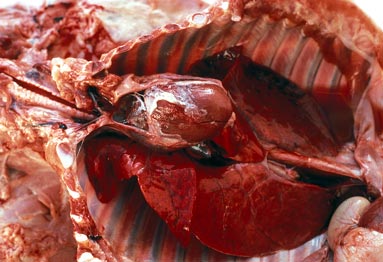Bacteria:
The most important bacterial disease is Mycoplasma hyopneumoniae without doubt. It is acquired in huge numbers post-weaning in the face of rapid (possibly poor) maternal antibody production and rapidly colonises the lung causing cranial lobe pneumonias but most importantly colonises the lung for long periods of time, avoids the immune mechanisms and causes dysfunction of the ciliary defence and bronchiolar function. It is present across Europe except in SPF herds and where present all producers should vaccinate to reduce the immunological suppressive effects that it has. Remember that if you do vaccinate then you produce a susceptible population and should not suddenly stop vaccinating as they may go down with enzootic pneumonia.
There are consistent strains of Streptococcus suis usually types 1 and 2 (Fig. 7) across Europe but the other strains vary from country to country.


Figure 7: Streptococcus suis pericarditis and pleurisy
It is likely that there are strain variations across Europe with M. hyorhinis but the jury is still out as to whether this is a pathogen or not.
Actinobacillus pleuropneumoniae varies across Europe with regard to the strain and individual countries have always blamed other countries for sending over a strain previously non-existent in that country with the purchase of live pigs because who can truly certify that pigs are free from infection or disease when only a few organisms are found in the nasopharynx.
All countries have the major alimentary diseases such as Lawsonia intracellularis, Salmonellae and Brachyspirae hyodysenteriae and pilosicoli and it is also likely that there are strain variations within the individual countries of Europe.
In all the cases of bacterial infections the big variation in Europe is in the susceptibility to antibiotics with the MIC’s for APP for example showing huge variations between Italy, Spain and Switzerland. Similar results can be seen for MIC’s for Tiamulin and H. parasuis, Tetracycline and H. parasuis, Tilmicosin and H. parasuis.
Recently, there has been an upsurge in the interest in Methicillin-resistant Staphylococcus aureus infections (MRSA) particularly in pigs as a result of studies in the Netherlands and now Belgium, which showed high levels of infections in both pigs and humans associated with agriculture. Again this organism may show wide variation across Europe.
It is impossible to compare figures but in the B-Pex analysis of the Costs of Production for 2006 data set compiled by Tony Fowler it can be seen that with a few exceptions mortality results across Europe are very similar. These are shown in Table 1.
Table 1: Sow mortality, pre-weaning mortality, rearing mortality and finishing mortality across some European countries (all as %):
| BEL | DEN | FRA | GER | GB | IRE | IT | NL | SWE | |
| Sow mortality | 4,9 | 14,1 | 5,9 | 6,0 | 5,8 | 6,5 | 0,5 | 5,0 | 6,4 |
| Pre-weaning | 12,7 | 14,1 | 14,1 | 14,3 | 13,3 | 9,5 | 10,7 | 12,7 | 15,4 |
| Rearing | 3,9 | 3,2 | 2,3 | 3,0 | 2,5 | 3,3 | 3,3 | 2,0 | 2,7 |
| Finishing | 3,9 | 4,0 | 4,4 | 3,9 | 5,6 | 2,5 | 0,6 | 2,7 | 1,9 |
Figures in bold are not consistent and I have no explanation for these numbers which are not similar to the results for the rest of Europe and therefore have to assume that they are related to the collection of the figures.
It conclusion, it can be said there are not many new diseases emerging in Europe. The possible exception would be the arrival (hopefully not) of the “hot” Chinese strain of PRRS associated with 70-80% mortality in pigs under 17 weeks.
It is mainly the re-emergence of old ones.
Vaccination for PCV2 will be the most important advance in pig medicine in 10 years.
PRRS will continue to be a problem and may require eradication as the only long-term control.
The continual removal (often for the flimsiest of scientific reasons) of growth promoters and in particular the possible removal of zinc oxide post-weaning will be a major restraint on microbial control, freedom from disease and therefore economic production. Further restraints on antimicrobials for treatment may also be envisaged.
In addition to restrictions on use there may be problems associated with antimicrobial resistance as the use of the same drugs continues (no new antibiotic molecules for 20 years).
We need more vaccines for the alimentary pathogens as a priority.




